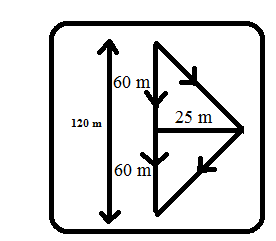Example
Use condition on path difference for two superimposing sound waves for constructive interference

Example: In a large room, a person receives direct sound waves from a source away from him. He also receives waves from the high ceiling at a point half way between them. For which wavelengths the two waves interfere constructively?
Solution:
Path difference is
phase change
Constructive interference for , where etc.
Thus, for
for
for etc.
Solution:
Path difference is
phase change
Constructive interference for , where etc.
Thus, for
for
for etc.
Definition
Define destructive interference and state condition on phase difference for destructive interference
If a crest of one wave meets a trough of another wave then the magnitude of the displacements is equal to the difference in the individual magnitudes this is known as destructive interference. For destructive interference where n=1,2,.....
Example
Use condition on path difference for two superimposing sound waves for destructive interference

Example: Two small loud speakers and are driven by the same amplifier as shown in figure and emit pure sinusoidal waves in phase. Speaker is away as shown and speaker is away from the amplifier. The microphone is away from the amplifier in transverse direction as indicated in the figure.Speed of sound is .
Solution:
Path difference between sound from the sources meeting at P=
For destructive interference, path difference= (n=0,1,2,3...)
.
Solution:
Path difference between sound from the sources meeting at P=
For destructive interference, path difference= (n=0,1,2,3...)
.
Definition
Constructive Interference
Constructive interference occurs when the phase difference between the waves is an even multiple of (180) (a multiple of 2, 360)etc.
Definition
Destructive Interference
Destructive interference occurs when the difference is an odd multiple of . ... At some points, these will be in phase, and will produce a maximum displacement
Definition
Equation of Standing Wave
Standing Waves:
A wave travelling along the +x direction is reflected at a fixed point. The result of its superposition is a standing wave.
If
So, no motion for these points (nodes).
If
So, these points oscillate with the maximum possible amplitude (antinodes).
A wave travelling along the +x direction is reflected at a fixed point. The result of its superposition is a standing wave.
If
So, no motion for these points (nodes).
If
So, these points oscillate with the maximum possible amplitude (antinodes).
Definition
Hormonics and Overtone
An overtone is any frequency greater than the fundamental frequency of a sound. Using the model of Fourier analysis, the fundamental and the overtones together are called partials. Harmonics, or more precisely, harmonic partials, are partials whose frequencies are integer multiples of the fundamental (including the fundamental which is 1 time itself).
Definition
Define and find higher harmonics and overtones for standing wave in a string fixed at one end
.
These are the normal frequencies of vibration. The fundamental frequency is obtained when n=0, ie,
.
The overtone frequencies are
,
,
, etc.
These are the normal frequencies of vibration. The fundamental frequency is obtained when n=0, ie,
.
The overtone frequencies are
,
,
, etc.
| BookMarks |
Page 11 Page 12 Page 13 Page 14 Page 15
0 Comments
Post a Comment